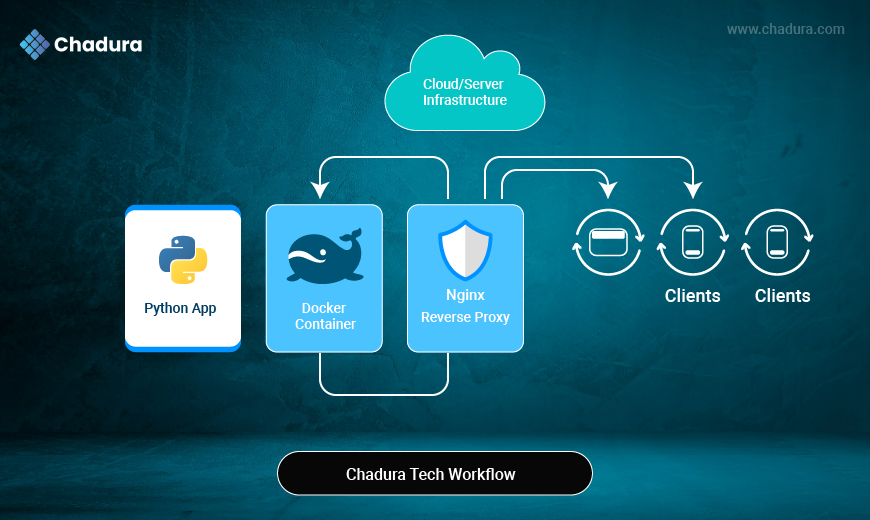1.How Chadura Tech Does Deployment
At Chadura Tech, we believe that delivering robust Python web applications requires more than just writing good code. It’s about reliable deployment, consistency, and scalability. Over the years, our DevOps and cloud teams have refined a workflow that combines Docker for containerization and Nginx for serving and managing traffic.
This blog explains how we deploy Python web apps at Chadura Tech, sharing insights from our production-ready setups. We’ll guide you through:
- Packaging Python applications with Docker
- Using Nginx as a reverse proxy and load balancer
- Scaling applications efficiently
- Implementing CI/CD pipelines the Chadura Tech way
By the end, you’ll understand our deployment philosophy, which emphasizes speed, reliability, and maintainability.
2. Deployment Challenges We Faced
Before adopting Docker and Nginx, Chadura Tech engineers encountered common deployment headaches:
- Dependency conflicts between projects
- Inconsistent environments across development, staging, and production
- Manual server setup errors
- Slow deployment cycles
These challenges slowed down delivery and sometimes caused downtime. Moving to containerized deployments with Docker allowed us to standardize environments and simplify management.
3. Why Docker is Our Go-To Solution
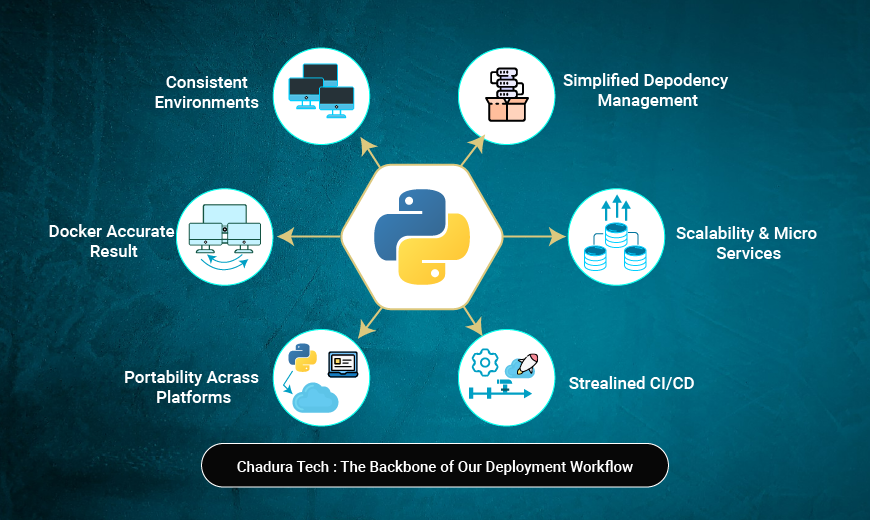
Docker is a game-changer at Chadura Tech because it provides:
3.1 Consistency Across Environments
Every container we deploy is identical from development to production, reducing the “works on my machine” problem.
3.2 Simplified Dependency Management
Python projects often involve dozens of packages. Docker isolates dependencies, making upgrades safe and preventing conflicts.
3.3 Portability
Our teams deploy containers to AWS, Azure, and on-prem servers. Docker ensures apps run exactly the same wherever they are hosted.
3.4 Scalability
We can scale applications horizontally by running multiple containers, handled either by Docker Compose or orchestration platforms like Kubernetes.
3.5 CI/CD Integration
Docker integrates with our Jenkins and GitHub Actions pipelines, automating testing, building, and deploying applications reliably.
4. Why Nginx is Essential in Our Stack
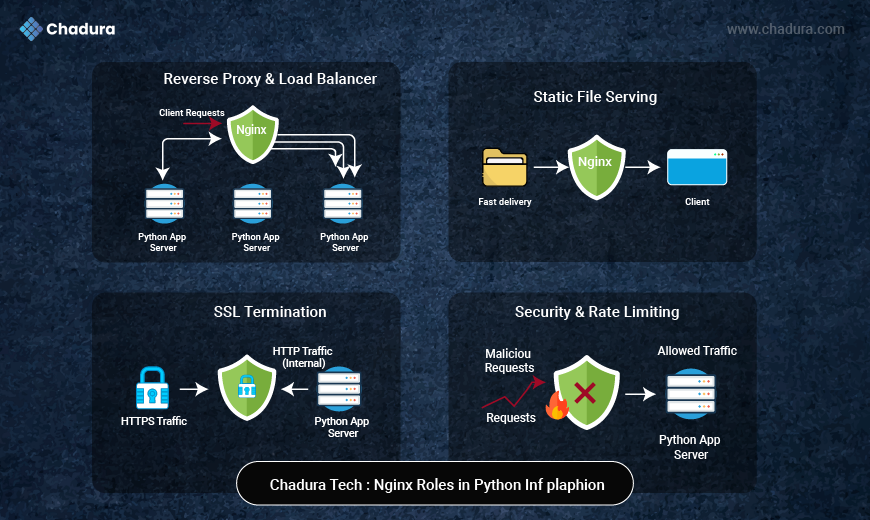
At Chadura Tech, Nginx is a key part of our deployment architecture because it:
- Acts as a reverse proxy, routing traffic to backend containers
- Handles static files, offloading them from Python apps
- Provides SSL termination using Let’s Encrypt
- Improves performance and scalability
- Adds a layer of security via rate limiting and request filtering
Together, Docker and Nginx form the backbone of our modern Python deployments.
5. Building Python Web Apps at Chadura Tech
We typically start with Flask or Django depending on the project. Here’s an example Flask app we use for internal demos:
from flask import Flask
app = Flask(__name__)
@app.route('/')
def home():
return "Welcome to Chadura Tech – Powered by Docker & Nginx!"
if __name__ == '__main__':
app.run(host='0.0.0.0', port=5000)This app will be containerized and served through Nginx for production.
6. Creating Dockerfiles – Chadura Tech Standard
We follow best practices for production-ready Dockerfiles:
FROM python:3.10-slim
WORKDIR /app
COPY . /app
RUN pip install --no-cache-dir flask gunicorn
CMD ["gunicorn", "-b", "0.0.0.0:5000", "app:app"]Why this works for us:
- Lightweight Python image keeps containers small
- Gunicorn runs the app in production mode
No unnecessary dependencies increase security
7. Running Docker Containers the Chadura Tech Way
7.1 Build the Docker Image
docker build -t chadura-flask-app .7.2 Run the Container
docker run -d -p 5000:5000 chadura-flask-appAt Chadura Tech, we always map ports and set container names clearly for easy monitoring and management.
8. Docker Compose for Multi-Service Apps
Most of our projects involve multiple services: app, database, cache, and Nginx. We use Docker Compose to manage these dependencies:
version: '3'
services:
web:
build: .
container_name: chadura_web
ports:
- "5000:5000"
restart: always
nginx:
image: nginx:latest
container_name: chadura_nginx
ports:
- "80:80"
- "443:443"
volumes:
- ./nginx/conf.d:/etc/nginx/conf.d
depends_on:
- web9. Nginx Configuration – Chadura Tech Approach
We configure Nginx as a reverse proxy for all Python apps:
server {
listen 80;
location / {
proxy_pass http://web:5000;
proxy_set_header Host $host;
proxy_set_header X-Real-IP $remote_addr;
}
}This ensures requests reach the correct container, improving reliability in production.
10. Handling Static and Media Files
For Django projects, we mount static and media directories as volumes:
location /static/ {
alias /app/static/;
}
location /media/ {
alias /app/media/;
}This approach offloads static content from Python processes, improving performance.
11. HTTPS & Security – Chadura Tech Best Practices
We always enforce HTTPS using Let’s Encrypt:
sudo certbot --nginx -d example.comOther security measures:
- Avoid root in containers
- Scan images with docker scan
- Rate limiting and request filtering in Nginx
Security is non-negotiable in all Chadura Tech deployments.
12. Logging and Monitoring
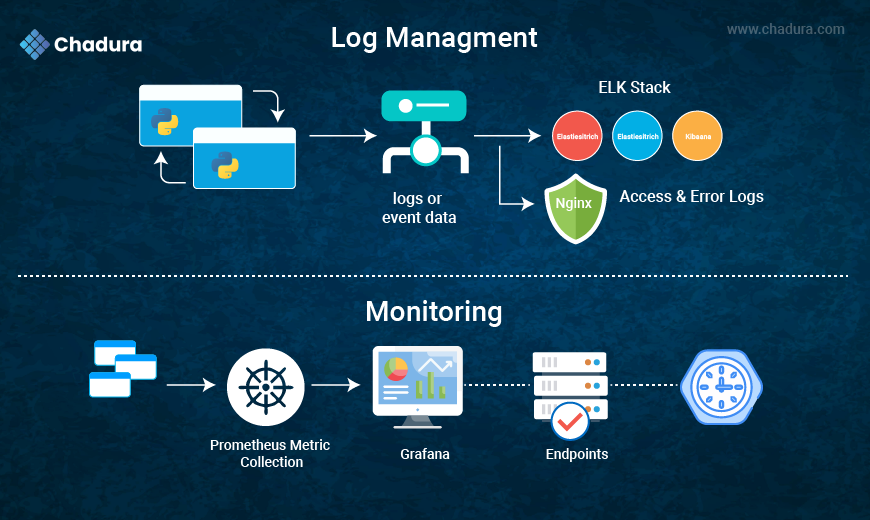
Chadura Tech integrates logging and monitoring for all containers:
- Docker logs are centralized with ELK Stack
- Nginx logs track access and errors
- Prometheus + Grafana monitor container metrics
- Uptime checks ensure app reliability
This allows our teams to proactively detect issues and maintain uptime.
13. Scaling Containers
We frequently scale Python apps horizontally:
docker-compose up --scale web=3 -dNginx handles traffic distribution. This ensures apps can handle spikes in traffic without downtime.
14. CI/CD Pipelines at Chadura Tech
Our deployment pipelines automate:
- Docker builds
- Testing
- Security scans
- Pushing images to ECR/GitHub
- Deployment via Docker Compose or Kubernetes
Example Jenkins snippet:
pipeline {
stages {
stage('Build') { steps { sh 'docker build -t chadura/flask-app:${BUILD_NUMBER} .' } }
stage('Push') { steps { sh 'docker push chadura/flask-app:${BUILD_NUMBER}' } }
stage('Deploy') { steps { sh 'docker-compose up -d' } }
}
} This ensures faster, repeatable, and error-free deployments.
15. Production Optimization Tips
From Chadura Tech’s experience:
- Use multi-stage Docker builds
- Enable caching and gzip compression in Nginx
- Use a CDN for static assets
- Run multiple Gunicorn workers for concurrency
These optimizations enhance performance and reduce costs.
16. Deploying on Cloud – Our Strategy
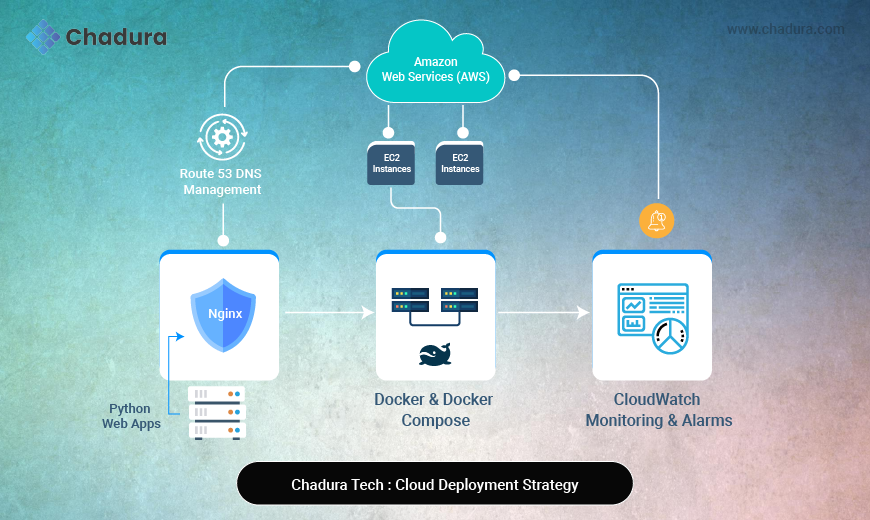
Chadura Tech frequently deploys on AWS ECS, EC2, and Lightsail:
- EC2 instances with Docker & Compose
- Nginx reverse proxy for domains
- Route 53 for DNS management
- CloudWatch for monitoring
This approach combines scalability, observability, and ease of management.
17. Common Issues & Chadura Tech Solutions
- Nginx 502 errors : Check container names, network configuration
- Static files not loading:Ensure correct volume and alias paths
- SSL renewal failed : Properly mount /etc/letsencrypt and automate renewal
- Container crashes : Use Gunicorn logging, health checks, and resource limits
18. Conclusion – Chadura Tech Deployment Philosophy
At Chadura Tech, our deployment strategy emphasizes:
- Reliability: Every deployment works consistently
- Scalability: Apps handle high traffic seamlessly
- Security: Best practices for containers and web servers
- Automation: CI/CD pipelines for speed and efficiency
By combining Docker and Nginx, we deliver Python web applications that meet enterprise standards, providing our clients with secure, high-performance, and maintainable solutions.
19. Image Suggestions for Chadura Tech Blog
- Title Image: Modern illustration with Python, Docker, Nginx icons, showing enterprise cloud deployment.
- Docker Architecture: Containerized Flask/Django app communicating with Nginx.
- CI/CD Flow: Jenkins automating build, test, and deploy.
- Scaling Architecture: Nginx load balancing across multiple containers.


